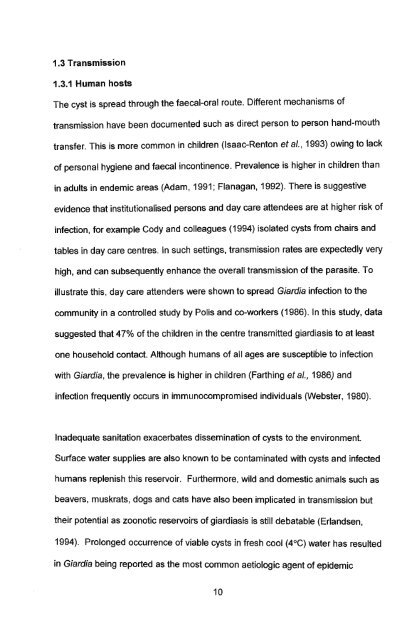in vitro culture and isoenzyme analysis of giardia lamblia
in vitro culture and isoenzyme analysis of giardia lamblia
in vitro culture and isoenzyme analysis of giardia lamblia
Create successful ePaper yourself
Turn your PDF publications into a flip-book with our unique Google optimized e-Paper software.
1.3 Transmission<br />
1.3.1 Human hosts<br />
The cyst is spread through the faecal-oral route. Different mechanisms <strong>of</strong><br />
transmission have been documented such as direct person to person h<strong>and</strong>-mouth<br />
transfer. This is more common <strong>in</strong> children (Isaac-Renton et al., 1993) ow<strong>in</strong>g to lack<br />
<strong>of</strong> personal hygiene <strong>and</strong> faecal <strong>in</strong>cont<strong>in</strong>ence. Prevalence is higher <strong>in</strong> children than<br />
<strong>in</strong> adults <strong>in</strong> endemic areas (Adam, 1991; Flanagan, 1992). There is suggestive<br />
evidence that <strong>in</strong>stitutionalised persons <strong>and</strong> day care attendees are at higher risk <strong>of</strong><br />
<strong>in</strong>fection, for example Cody <strong>and</strong> colleagues (1994) isolated cysts from chairs <strong>and</strong><br />
tables <strong>in</strong> day care centres. In such sett<strong>in</strong>gs, transmission rates are expectedly very<br />
high, <strong>and</strong> can subsequently enhance the overall transmission <strong>of</strong> the parasite. To<br />
illustrate this, day care attenders were shown to spread Giardia <strong>in</strong>fection to the<br />
community <strong>in</strong> a controlled study by Polis <strong>and</strong> co-workers (1986). In this study, data<br />
suggested that 47% <strong>of</strong> the children <strong>in</strong> the centre transmitted <strong>giardia</strong>sis to at least<br />
one household contact. Although humans <strong>of</strong> all ages are susceptible to <strong>in</strong>fection<br />
with Giardia, the prevalence is higher <strong>in</strong> children (Farth<strong>in</strong>g et al., 1986) <strong>and</strong><br />
<strong>in</strong>fection frequently occurs <strong>in</strong> immunocompromised <strong>in</strong>dividuals (Webster, 1980).<br />
Inadequate sanitation exacerbates dissem<strong>in</strong>ation <strong>of</strong> cysts to the environment.<br />
Surface water supplies are also known to be contam<strong>in</strong>ated with cysts <strong>and</strong> <strong>in</strong>fected<br />
humans replenish this reservoir. Furthermore, wild <strong>and</strong> domestic animals such as<br />
beavers, muskrats, dogs <strong>and</strong> cats have also been implicated <strong>in</strong> transmission but<br />
their potential as zoonotic reservoirs <strong>of</strong> <strong>giardia</strong>sis is still debatable (Erl<strong>and</strong>sen,<br />
1994). Prolonged occurrence <strong>of</strong> viable cysts <strong>in</strong> fresh cool (4°C) water has resulted<br />
<strong>in</strong> Giardia be<strong>in</strong>g reported as the most common aetiologic agent <strong>of</strong> epidemic<br />
10
















